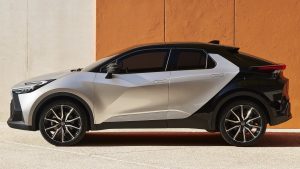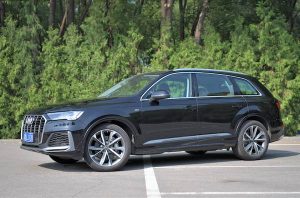2024 Chevrolet Trax vs 2024 Honda HR-V
The Chevrolet Trax has come a long way since the 1st generation, but now with it’s more aggressive looks and larger road presence, the Trax has joined the growing trend of brands producing bigger subcompact crossovers, that quite frankly are becoming affordable family friendly vehicles that offer a plethora of comfort and convenience features not previously seen in this segment before. One rival that comes to mind is the new Honda HR-V that also went through a bit of a growth spurt and switched platforms to better meet the demands of car shoppers in the price range below $30k. So let’s see how the 2024 Trax stacks up against a worthy foe in this segment.
Performance
Starting off with the Trax, Chevrolet dropped in a 1.2L turbocharged 3 cylinder engine that produces 137 hp and 162 lb ft of torque, but the key takeaway here is that this powertrain is paired with a 6 speed automatic transmission. Subcompacts have never been known to be the most engaging nor the quickest, but manufacturers are attempting to change all of that by at least giving owners the perception of quality and overall enjoyment behind the wheel. With a 0-60 time of around 9 seconds, the Trax isn’t a barnstormer and you’re certainly not going to get pushed back in your seat during heavy accelerations, however because you have a turbo and traditional automatic, you won’t experience the constant droning like we hear in rivals when entering highways, and that is further compounded by the 3 cylinder engine that’s relatively quiet compared to most naturally aspirated 4 cylinders that are typically offered in this market.
What caught us by surprise was the handling and steering input, as there was a faint feeling of weight when approaching sharper corners on backroads, which is not something you’d expect for a crossover priced at $25k. Because the Trax is essentially a lifted hatchback, it’s car-like onroad demeanor hides the usually lackluster handling that subcompacts are known for and since the Trax is not performance oriented the suspension isn’t all that rigid. However this crossover does just enough to not lull you to sleep, and with an open mind, you could find yourself enjoying your weekly commutes with the Trax.
The Honda HR-V on the other hand, has many strengths, but the driving dynamics aren’t one of them. Under the hood is a 2 liter 4 cylinder engine that produces 158 hp and 138 lb ft of torque which is paired with a CVT. The key differences between these two crossovers boil down to the transmission and the discrepancy in lb ft of torque for the HR-V, as this subcompact gasps for air when trying to pass slower drivers on the highway, and the CVT hammers home the same faults that plague vehicles in this price range. Yet even with it’s shortcomings for straightline speed, buyers will love the more rigid suspension that underpins the HR-V, as the independent rear suspension improves ride quality and does provide some level of cushioning when going over uneven pavement.
The HR-V has always been chosen for it’s practicality and fuel efficiency above everything else, and while Honda has made great strides in changing the perception surrounding this crossover, performance-wise it would be better served with a stronger powertrain, whether that means dropping in a turbo or maybe offering a hybrid variant much like the rest of the lineup.
Features
In the subcompact crossover segment you won’t be receiving all the bells and whistles, as many comfort features are often reserved for larger vehicles in brand’s lineups, but you may be genuinely surprised to find out that the Honda HR-V and Chevy Trax provides an ownership experience that might catch you off-guard if you’ve purchased cars or crossovers in this price range before. The models we had featured and are shown throughout this video is an HR-V Sport and Trax 2RS, which ironically cost around $25k making this comparison more accurate. However there are some distinct differences if you opt for the top trims from both vehicles that you may find appealing.
First for the HR-V, the interior does offer some softer touch materials to elevate the driving experience, but compared to last generation, you’ll have some amenities and modern tech that fits it’s mid to high $20k price point. While not equipped on the Sport, the HR-V gives you dual zone climate control, heated leather trimmed seats, with the driver’s side being power adjustable, a 9 inch touchscreen, which is only available for the EX-L, wireless apple CarPlay and android auto compatibility, a wireless phone charging pad, and a half digital half analogue gauge cluster. If tech features aren’t a top priority and you want to stay strict with your budget, the Sport is a great option, as the heated cloth seats offer a good amount of support and cushioning and the smaller head unit is still intuitive with the basic necessities. More importantly, the HR-V gets the same dashboard from the redesigned Honda Civic, which does have a classy and clean look.
The Trax on the other hand is at it’s best for the 2RS and Activ, as Chevy spared no expense to give driver’s a tech dominated cabin. Unlike the HR-V you will have a full digital instrument display that is custimizable and showcases a wide range of information. You’ll also have an 11 inch touchscreen that really isn’t too different from Honda’s user interface in terms of what it provides when it pertains to features. Just like the HR-V you’ll have wireless apple CarPlay and android auto compatibility with a wireless phone charging pad being available. However the Trax does not offer dual zone climate control, and while we do like the sportier exterior design of the 2RS, opting for the Activ will make more sense as heated seats and a power adjustable driver’s seat makes you feel you’re getting more for $25k.
Comfort wise, the leatherette upholstery is typical for a crossover in this market, but one key difference is that there’s harder touch plastics on the door panels and dashboard, however that would be expected for a vehicle priced under $30k. All-in-all, both crossover share many similarities in terms of what they offer, and ultimately it will come down to pricing as a top trim EX-L for the HR-V will be creeping towards that’s 30 grand mark whereas the Trax hovers closer to $26-$27k.
Capability/Versatility
Where the Trax and HR-V both improved with their new generations was upsizing to become almost compact crossover-like, and that’s not only apparent from the outside but also the interiors that we just highlighted. Both subcompacts traveled similar paths to where they are today, as the HR-V is 10 inches longer and two inches wider than it’s predecessor, making it larger than the Toyota Corolla Cross, Subaru Crosstrek and Mazda CX-30. Similar to the HR-V, for 2024, the Trax grows in length by 11 inches, and is 2 inches wider than the crossover it’s replacing, making both subcompacts some of the bigger options in this segment, and because of that they’re also very practical, to a point where you may not need to buy a more expensive compact crossover.
For the cargo space, the HR-V comes in with 24.4 Cubic ft of room behind the 2nd row seats, and when those seats are folded that nearly doubles size to 55 cubic ft. The Trax will offer 25.6 cubic ft initially when the 2nd row seats are up and 54 cubic ft when folded. From a practicality perspective, both a nearly identical, but more importantly outclass the Subaru Crosstrek and Mazda CX-30, making Chevy and Honda family friendly alternatives.
Now, a potential deciding factor is that the Trax currently doesn’t offer AWD as an option, which could steer buyers in a different direction if they feel more comfortable driving a crossover with something other than FWD, and that’s where the HR-V slots into place, but it should be worth mentioning that to opt for AWD you’ll be paying an additional $1500. Lastly for off-road capability, both the Trax and HR-V will have just over 7 inches of ground clearance, but it’s highly unlikely you’ll be encountering terrain besides pavement with either crossover.
Conclusion
All-in-all the Chevy Trax and Honda HR-V in 2023 are vast improvements from where both crossovers were just a few years ago. They’re no longer econoboxes, and instead they’re vehicles of substance that offer an array of features to make them great values on the market today. If performance and technology is what you’re looking for, we’d lean towards the Trax, however the HR-V does have a better interior, especially if you decide to purchase an EX-L with the leather seats and 9 inch touchscreen. Of course it boils down to personal preference, but we’d say the Trax is a more appealing option right now in 2023.
If you’re interested in finding out more about the Chevy Trax or Honda HR-V check out our full reviews!


